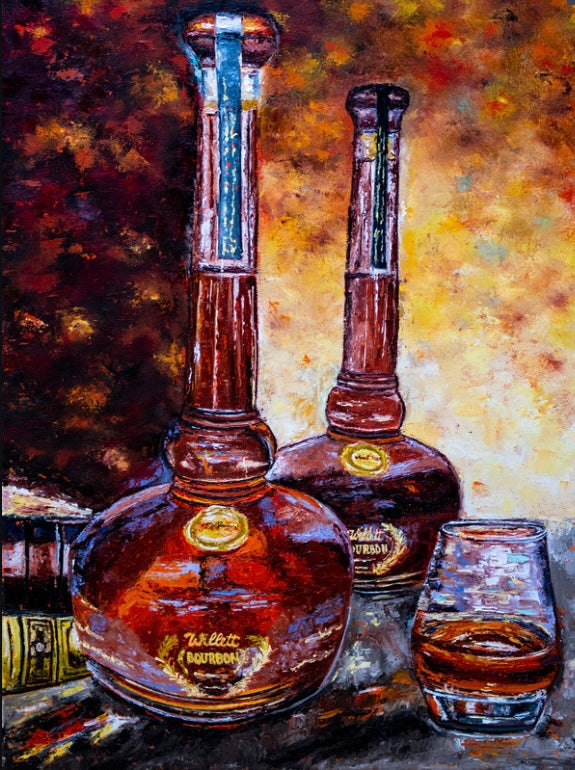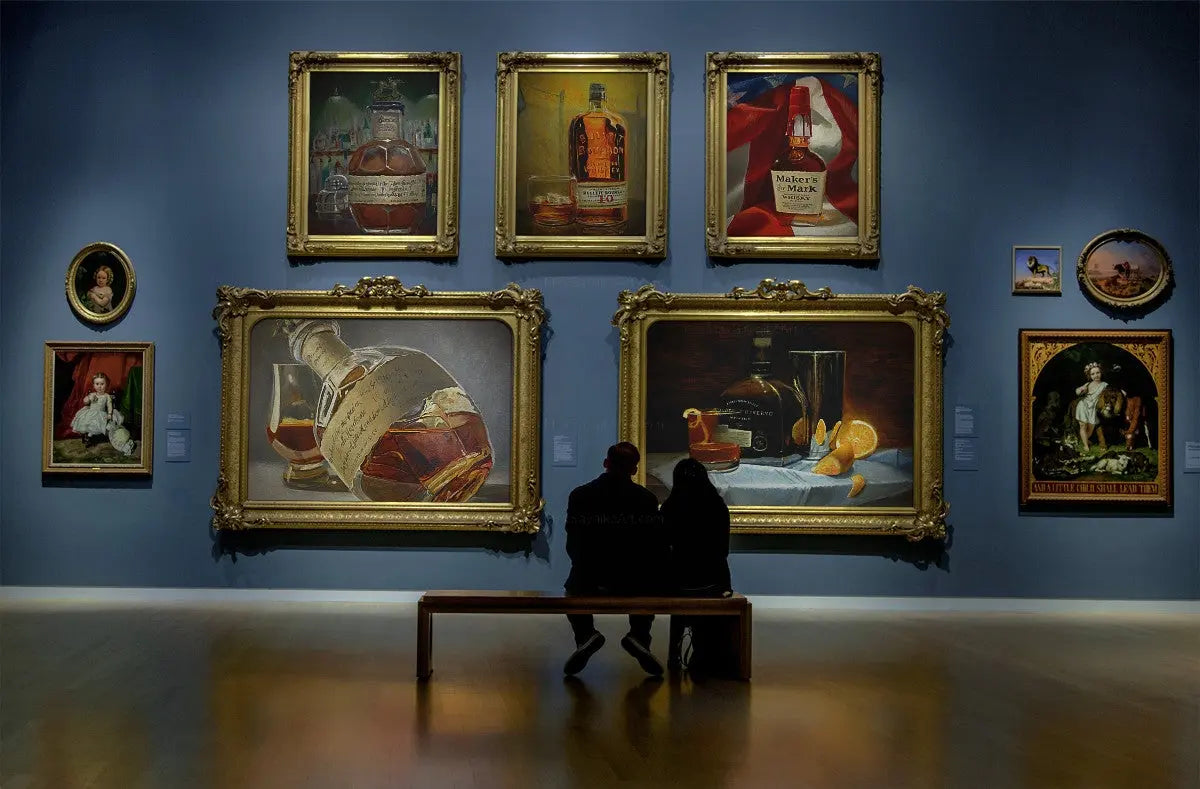Limited Edition Bourbon Art: Why Collectors Are Crowding to One-of-a-kind Finds
The Value of Whiskey Art in Celebrating Heritage and Workmanship in the Beverage Sector
The intricate connection in between whiskey art and the event of heritage and craftsmanship within the beverage industry can not be overstated. With attentively made labels and bottles, scotch brands envelop their historic roots and the artisanal skills that define their production approaches.
The Historical Roots of Whiskey
At the heart of whiskey's appeal exists an abundant tapestry of historic origins that map back to ancient civilizations. The origins of bourbon can be connected to the distillation methods of the Sumerians and Babylonians around 2000 BCE, where early kinds of fermented grain beverages started to arise. Nonetheless, it was in the Center Ages that the art of purification advanced considerably, particularly in Ireland and Scotland, resulting in the production of bourbon as we understand it today.
The term "scotch" itself originates from the Gaelic word "uisce beatha," suggesting "water of life." This expression emphasizes the social relevance of bourbon in Celtic cultures, where it was usually connected with rituals, parties, and common bonding. By the 15th century, purification ended up being a recognized craft within reclusive areas, leading the way for the facility of legal distilleries.
As trade paths expanded, scotch's popularity expanded, going beyond local limits and capturing the rate of interest of aficionados worldwide. Limited Edition. This historical trip reflects not just the workmanship behind whiskey manufacturing however additionally its integral role in social and social contexts, noting it as a significant drink throughout background
Artistic Expression in Branding
Bourbon branding stands as a compelling crossway of virtuosity and business, where visual identity plays an important role fit customer perception. The aesthetic appeals of bourbon tags, packaging, and advertising materials show not just the brand's tale but likewise its core values and heritage. With creative expression, distilleries communicate a story that resonates with consumers, evoking emotions and triggering links.
Using shade, typography, and images in branding offers to differentiate products in a saturated market. For instance, traditional motifs may stimulate a feeling of credibility and workmanship, while modern-day layouts can signify innovation and forward-thinking. This strategic creative direction enhances brand name recognition and loyalty, enabling consumers to create an individual connection with the whiskey they select.
In addition, imaginative expression in branding typically works as a party of regional heritage. Distilleries often incorporate neighborhood signs or historic references into their layouts, creating a feeling of area that welcomes customers to take part in a wider cultural experience. Eventually, the artistry behind scotch branding not only enhances aesthetic appeal but likewise enhances the total narrative of the brand name, promoting a much deeper recognition for the workmanship and heritage embedded in each bottle.
Workmanship in Bottle Design
The virtuosity apparent in whiskey branding prolongs beyond visual identification to encompass the craftsmanship associated with container style. Each bottle works as a vessel not just for the spirit within, however additionally for the story it tells concerning its practice, beginning, and quality. The layout process requires thorough attention to detail, as aspects such as form, product, and closure contribute substantially to the general assumption of the bourbon.
Craftsmanship in bottle layout includes picking premium glass that can enhance the whiskey's shade and clarity, while also offering a tactile experience for the consumer. The shape of the bottle need to be both practical and cosmetically enticing, typically mirroring the heritage of the brand name. Numerous distilleries decide for special shapes or embossed logos that stimulate a sense of authenticity and background.
Additionally, the label design and typography play a crucial function in interacting the brand name's story. Limited Edition. A well-crafted bottle not only astounds the consumer's eye however additionally strengthens the brand name's dedication to quality and practice. This way, the workmanship of bottle style comes to be an important facet of Resources the whiskey experience, merging virtuosity with a profound regard for heritage
Social Relevance of Bourbon Art
Commemorating custom and craftsmanship, the cultural importance of scotch art transcends plain visual appeals, intertwining with the historical and social narratives of the regions where it originates. Each bottle works as a canvas, illustrating the one-of-a-kind tales, folklore, and traditions that have actually shaped neighborhood whiskey-making methods. The intricate designs typically reflect the heritage of the distillers, integrating symbols and themes that reverberate with the culture and values of their communities.

On top of that, bourbon art plays a crucial duty in public events and parties, serving as a concrete link in between people and their shared experiences. By appreciating the creativity in whiskey packaging, consumers grow a deeper understanding and respect for the craft, eventually enhancing their enjoyment of the drink itself.
Modern Trends in Bourbon Discussion
In recent years, the discussion of scotch has evolved to mirror modern tastes and fads while still recognizing traditional craftsmanship - Realism Art. Distilleries are progressively focusing on aesthetic components that improve the total drinking experience, bridging the void in between heritage and modernity
Ingenious container styles have actually emerged, often integrating lasting materials and imaginative tags that tell engaging stories. Many visite site brands now work together with regional artists, instilling their products with distinct visual expressions that resonate with consumers. Additionally, limited-edition launches are usually packaged in collectible containers, adding value and appeal for connoisseurs.

Verdict
Finally, scotch art functions as a crucial channel for sharing the heritage and workmanship inherent in the beverage sector. With intricate branding, cutting-edge container styles, and culturally considerable creative components, whiskey brands efficiently honor their practices and connect with consumers. This imaginative narrative not only raises the appreciation of scotch yet additionally reinforces neighborhood identification and satisfaction amongst producers. Ultimately, scotch art plays an essential role in preserving and commemorating the rich social tapestry of whiskey-making.


Workmanship in bottle style includes selecting high-quality glass that can enhance the whiskey's color and clarity, while additionally supplying a tactile experience for the customer. In this means, the workmanship of bottle layout comes to be an essential element of the bourbon experience, combining artistry with an extensive regard for heritage.
In conclusion, bourbon art offers as a crucial conduit for revealing the heritage and workmanship intrinsic in the drink sector.